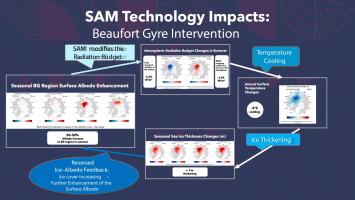评估局部人工增强波弗特环流海冰反照率对恢复北极海冰的影响
IF 3.8
2区 工程技术
Q1 ENGINEERING, CIVIL
引用次数: 0
摘要
CMIP6的预测显示,到2050年,北极可能会无冰,导致全球气候破坏,如不稳定的极地急流、更强的风暴和更长时间的干旱。仅靠减少温室气体排放不足以保护北极海冰,需要额外的气候恢复努力。Field等人(2018)提出用反射中空玻璃微球(HGMs)人工增强表面海冰反照率来恢复海冰,他们的建模模拟显示了该技术在北极海冰恢复中的潜力。虽然北极范围内的应用是昂贵的,但本地化的目标部署可能是可行的。本文研究了在波弗特环流(BG)应用区域地表反照率修正(SAM)对北极海冰和大气辐射收支的影响和效果。我们利用全球CESM2气候模式对BG地区的SAM进行了模拟,进行了50年(2000-2050)整合的10个成员集合。我们的研究结果表明,BG区域表面反照率增强约50%,使夏季吸收的地表辐射减少约5 W/m2,并使大气顶部的外向辐射增加约4.34 W/m2,与潜在的SSP2-4.5情景中全球人为辐射强迫的4.5 W/m2相当。这些辐射收支变化每年使北极表面降温0.78°C,使BG区降温3°C,并使BG区夏季海冰增厚高达1米。我们的研究结果表明,有针对性的SAM可以帮助保护北极海冰,并延迟北冰洋无冰,提供一个可行的临时气候干预措施。本文章由计算机程序翻译,如有差异,请以英文原文为准。

Evaluating the impacts of localized artificial enhancement of sea ice albedo over Beaufort Gyre towards restoring Arctic Sea Ice
CMIP6 projections show that the Arctic could be ice-free by 2050, leading to global climate disruptions like destabilizing polar jets, stronger storms and prolonged droughts. Reducing greenhouse gas emissions alone will not be sufficient to preserve Arctic sea ice, necessitating additional climate restoration efforts. Field et al. (2018) proposed restoring sea ice by artificially enhancing surface sea ice albedo with reflective hollow glass microspheres (HGMs) and their modeling simulations show the potential of this technology in Arctic sea ice recovery. While Arctic-wide application is expensive, localized targeted deployments may be feasible. Here we investigate the impacts and efficacy of regional surface albedo modification (SAM) application in the Beaufort Gyre (BG) on the Arctic sea ice and atmospheric radiation budget. We simulate SAM in the BG region carrying out a ten-member ensemble of 50 years (2000–2050) integrations using a global CESM2 climate model. Our results show that ∼50 % surface albedo enhancement in the BG region reduces absorbed surface radiation by ∼5 W/m2 and increases outgoing radiation at the top of the atmosphere by ∼4.34 W/m2 during summer, comparable to the global anthropogenic radiative forcing of 4.5 W/m2 in the underlying SSP2–4.5 scenario. These radiation budget changes cool the surface of Arctic annually by 0.78 °C, BG area by 3 °C and thicken the BG area summer sea ice by up to ∼1 m. Our findings suggest that targeted SAM could help preserve Arctic sea ice, and delay an ice-free Arctic ocean, offering a viable interim climate intervention.
求助全文
通过发布文献求助,成功后即可免费获取论文全文。
去求助
来源期刊

Cold Regions Science and Technology
工程技术-地球科学综合
CiteScore
7.40
自引率
12.20%
发文量
209
审稿时长
4.9 months
期刊介绍:
Cold Regions Science and Technology is an international journal dealing with the science and technical problems of cold environments in both the polar regions and more temperate locations. It includes fundamental aspects of cryospheric sciences which have applications for cold regions problems as well as engineering topics which relate to the cryosphere.
Emphasis is given to applied science with broad coverage of the physical and mechanical aspects of ice (including glaciers and sea ice), snow and snow avalanches, ice-water systems, ice-bonded soils and permafrost.
Relevant aspects of Earth science, materials science, offshore and river ice engineering are also of primary interest. These include icing of ships and structures as well as trafficability in cold environments. Technological advances for cold regions in research, development, and engineering practice are relevant to the journal. Theoretical papers must include a detailed discussion of the potential application of the theory to address cold regions problems. The journal serves a wide range of specialists, providing a medium for interdisciplinary communication and a convenient source of reference.
 求助内容:
求助内容: 应助结果提醒方式:
应助结果提醒方式:


